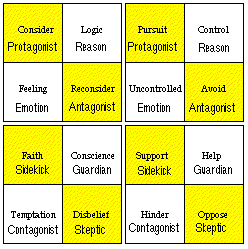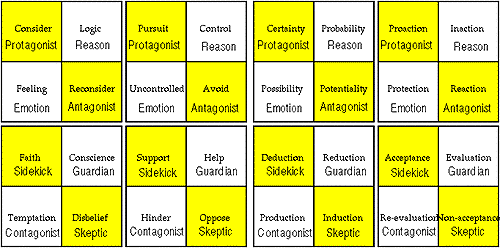Dramatica: A New Theory Of Story
By Melanie Anne Phillips & Chris Huntley
Chapter 9
Other Character Dimensions
What’s the Purpose?
- When authors describe their characters, they are often asked to state a characters’ motivations. A common reply might be, “The character Jane wants to be president.” Often that is accepted as a valid motivation. In fact, becoming president is Jane’s Purpose, not her motivation. Her motivation may be that she felt no control over her life as a child. Or she might be motivated by a love of the natural world, hoping to instigate a national conservation plan. She might be motivated by a desire for an equal rights amendment.Just knowing what her purpose is does not tell us anything about what Jane is driven by but only what she is driven toward. Any of the stated motivations would be sufficient to explain Jane’s purpose of becoming president. Conversely, if Jane’s motivation were the first example – a lack of control over her life as a child – several different purposes might satisfy that motivation. She might become a school teacher, a drill sergeant, or a religious leader. Clearly, motivations do not specifically dictate purposes, nor are purposes indicative of any particular motivations.
Step into the Fourth Dimension….
- In Dramatica, we refer to Motivation as a Character Dimension. Often it is said that characters must be three-dimensional to seem like real people. Dramatica sees four dimensions as necessary to flesh out a character. Motivations and Purposes are the first and last dimensions, but that is not enough. Motivation gives a character the force to move, Purpose gives a character a direction in which to move. But how is he actually going to get to where he wants to go? For this, he needs a Methodology, which is the third dimension of character. Methodologies describe the kinds of approaches a character might use in its efforts to achieve its purposes.This might seem like enough dimensions. After all, we have a beginning (motivation), a middle (methodology), and an end (purpose). Still, there is one remaining dimension lacking: Evaluations. Evaluations are the standards by which characters measure their progress.
All right, Buddy… Where’s the conflict?!
- As an example of the concept of Evaluation, imagine two business partners who share motivations, methodologies and purposes. They might agree on what drives them (a motivation to be independent), what they want to achieve (a purpose of creating a thriving business), and how to achieve that (word-of-mouth advertising as a methodology). Still, they might argue if sales are up but satisfaction is low because one evaluates based on gross sales and the other evaluates based on customer satisfaction. Their word-of-mouth methodology brings in more business because their prices are good, but repeat business is non-existent because of poor customer satisfaction. As a result, the two partners argue all the time, even though they agree in all three dimensions of Motivation, Methodology, and Purpose.Difficulties can arise between characters in any one of the four dimensions, even though they might agree completely in one or more of the other dimensions. In short, characters are never fully developed unless they are represented in all four dimensions, and they may come into conflict over any combination of Motivations, Methodologies, Means of Evaluation, or Purposes.
The Sixty-Four Element Question
- Each of the character dimensions contains sixteen Elements, as we have already seen with Motivations. Each character dimension is referred to as a Set of Elements. All four Sets come together to create what is called a Chess Set (due to its eight by eight grid) as illustrated below:

- A good way to get a feel for the content of and relationships between character dimensions is through the Archetypal Characters. Beginning with the Motivation Set, when we superimpose the Archetypal Characters onto the character Elements, an “archetypal pattern” appears as follows:

Mapping the Archetypal Pattern
- The archetypal pattern formed in the Motivation Set clearly illustrates the consistency and balance of the character Elements. In each quad of four Elements, the items that are diagonal from one another hold the greatest potential for conflict because they are exact opposites.
For example, Pursuit is the opposite of Avoid. As a result, when we place the Protagonist on the Motivation of Pursuit, we would expect the Antagonist to represent Avoid. As we have illustrated in the previous section, that is exactly the case. Similarly, when we place the Reason Archetype on Logic, it comes as no surprise to find Emotion residing on Feeling, since it is diagonal from Logic. In fact, every pair of Archetypes that are in a diagonal relationship will generate the greatest dynamics between them. This is why we call two Elements in diagonal opposition a Dynamic Pair.

Archetypal Methodologies
- Shifting our attention to the Methodology Set, a very useful thing becomes evident. Because the Methodology Elements are also arranged in Dynamic Pairs, we can simply duplicate the Archetypal pattern from the Motivation Set and the Archetypal Characters will cover the Methods they represent in stories as well.


- For example, a Protagonist who is Motivated by Pursuit employs a Methodology of Pro-action, and a Skeptic who is Motivated to Oppose employs a Methodology of Non-Acceptance.This Archetypal Pattern continues through all four character dimensions such that a Protagonist will be motivated by Pursuit, employ a Methodology of Pro-action, Evaluate its progress by the Effect it has, and strive toward achieving Actuality as its Purpose. Each of the Archetypal Characters follows the same pattern for both its External and Internal characteristics, resulting in an alignment of character Elements in four dimensions.
-
Complex Dimensional Patterns
- Most stories tend to emphasize one dimension over the others. Character Motivations are often made most prominent. Still, many stories are written that compare the methods used by characters, question their purposes, or carry a message that a Means of Evaluation is actually the cause of the problem. Some characters become famous for characteristics other than Motivations, such as a notable detective who employs a methodology of Deduction.
Being aware of all four character dimensions adds a level of versatility in creating complex characters as well. Characters might be Archetypal in one dimension, but fall into complex patterns in another. Also, a character may have three Motivations that drive it, yet strive toward a single Purpose that it hopes will satisfy all three. Some characters may not be represented at all in one or more dimensions, making them both more complex and less well-rounded at the same time. To fully make the argument of any story, however, all sixty-four Elements must be represented in one character or another. In addition, a key point to remember is: Unless a character represents at least one Element, it is not fulfilling a dramatic function and is therefore being employed for storytelling only.
What’s In a Pair?
- Finally, we can use our Chess Set of Elements to learn something more about our character’s relationships. In each quad of Elements, we find not only Dynamic (diagonal) Pairs, but horizontal and vertical pairs as well. Horizontal Elements are called Companion Pairs, and vertical Elements are Dependent Pairs. Each kind of pair describes a different kind of relationship between the Elements, and therefore between the characters that represent them.In addition to the three types of pairs, we can look at each Element as a separate component and compare it to the overall nature of the quad itself. This Component approach describes the difference between any given Element and the family of Elements in which it resides (quad). Therefore, the degree of individuality the characters represent within the “group” can be explored.


- Dynamic Pairs describe Elements with the greatest opposition to one another. Whenever two opposing forces come together they will create either a positive or negative relationship. They can form a synthesis and create something greater than the sum of the parts or they can simply tear away at each other until nothing is left (destructive). Within a quad, one of the Dynamic Pairs will indicate a positive relationship, the other a negative one. Which is which depends upon other story dynamics.Companion Pairs contain the Elements that are most compatible. However, just being compatible does not preclude a negative relationship. In a positive Companion Pair, characters will proceed along their own paths, side by side. What one does not need they will offer to the other (positive impact). In a negative Companion Pair, one character may use up what the other needs. They are not against each other as in a negative Dynamic Pair, but still manage to interfere with each other’s efforts (negative impact).
Dependent Pairs are most complementary. In a positive sense, each character provides strengths to compensate for the other’s weaknesses (cooperation). Together they make a powerful team. In its negative incarnation, the Dependent Pair Relationship has each character requiring the other in order to proceed (codependency).
Components describe the nature of the Elements in relationship to the overall quad. On the one hand, the individual characters in a quad can be a group that works together (interdependency). The group is seen to be greater than the individual characters that comprise it, at the risk of overwhelming the individuality of its members. This is contrasted by identifying the disparate nature of each character in the quad (independency). Seen this way, the characters are noted for their distinguishing characteristics at the risk of losing sight of shared interests.
Dynamic Relationships are the most familiar to writers, simply because they generate the most obvious kind of conflict. Companion and Dependent Pairs are used all the time without fanfare, as there has previously been no terminology to describe them. Components are useful to writers because they allow characters in groups to be evaluated in and out of context.
By constructing characters with thought and foresight, an author can use the position of Elements in the Chess Set to forge relationships that are Dynamic in one dimension while being Companion and Dependent in others. Characters created with Dramatica can represent both the structural Elements of the Story Mind’s problem solving techniques and the dynamic interchange between those techniques.
Summary
- Altogether we have outlined four dimensions of characteristics, each fostering an aspect of the eight Archetypes. Each of the Archetypes can be sub-divided into internal and external Elements resulting in a total of sixteen Elements in each dimension — a total of sixty-four characteristics from all four dimensions with which to build characters. Complex character can be created by stepping out of the archetypal patterns and relationships.

